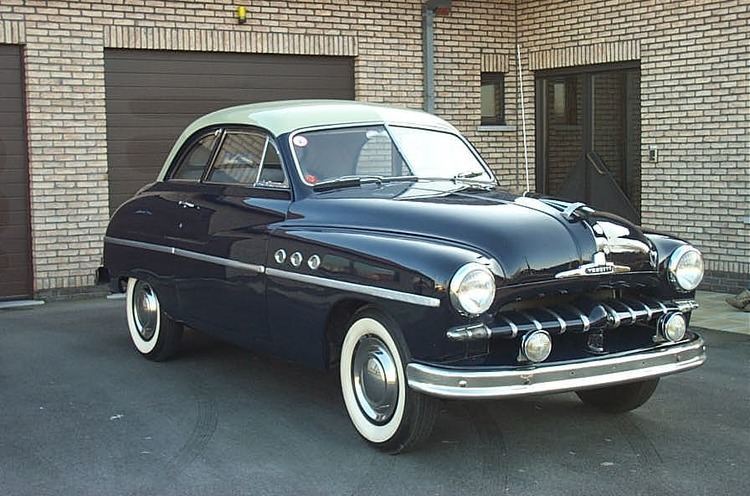Class Large car | Production 1948–1954 Layout FR layout | |
 | ||
Body style 4-door hatchback4-door saloon4-door landaulet5-door estate2-door coupé2-door cabriolet Related | ||
The Ford Vedette is a large car that was manufactured by Ford SAF in their Poissy plant from 1948-1954.
Contents
Introduced at the 1948 Mondial de l'Automobile in Paris, it was designed entirely in Detroit (resembling contemporary Mercury models) and featured the Poissy-made 2158 cc Aquillon sidevalve V8 engine of Ford's Flathead engine family, the same as in pre-war Matford cars. It was the only French car of its time with a V8 engine.
Uneasy beginnings
Because the Poissy factory could not resume complete automobile production immediately after World War II, many vital components had still to be made by various subcontractors, which reportedly had an adverse effect on the quality of the car and contributed to its limited popularity. Over the six years in production, the Vedette was available in several body styles, ranging from the original four-door fastback (with rear suicide doors) through the later four-door saloon, a Sunliner two-door landaulet based on the saloon (with a roll-down roof over the entire cabin), a two-door Coupé and, based on it, the Cabriolet Décapotable (a two-door convertible).
Enter Mr. Lehideux
Under the direction of the new company president, Mr. François Lehideux, Ford France refreshed the car for 1950, and again in 1952, when it finally received a one-piece windscreen, new interior and bumpers, better brakes, lengthened rear overhang and trunk - and a cigarette lighter. The 1953 October Mondial de l'Automobile also saw a luxury version of the Vedette, the Ford Vendôme, fitted with the bigger 3923 cc Mistral V8 engine, previously used in Ford France trucks.
Also updated in 1953 was the five-door, five-seat Abeille (French for "bee") estate with a two-piece tailgate, advertised as both practical (with a payload of 500 kg (1,100 lb)) and comfortable. The Abeille, originally exhibited with little fanfare at the October 1951 Motor Show as a "farmer's car" (voiture agricole) and launched more formally as the "Ford Abeille" in June 1952, was a "no frills" development of the Vedette with which it shared its wheel base and engine, but the rear overhang and therefore the overall length were shorter by 220 mm (8.7 in) The interior surfaces of the Abeille were almost without exception of painted metal, and the front bench seat of the Vedette was replaced with two "rustic" seats apparently taken from a commercial van, but behind them the rear bench was easy to remove, allowing for the installation of a flat "false-floor" of timber planks, and facilitating the use of the car as a load carrier for farmers and small-scale traders. At the October 1953 Motor Show the standard Abeille was listed at 845,000 Frances as against 935,000 francs for the least expensive version of the Vedette.
Enter Mr. Pigozzi
Facing unsatisfactory sales results, as well as disruptive strikes at the Poissy plant at the turn of the decade, Ford had been trying to dispose of the factory since shortly after the end of the war. An opportunity arose in 1954, when Henri-Theodore Pigozzi, the founder of the increasingly successful French automaker Simca, was looking for a new plant to expand its operations. Ford France was merged into Simca with both the Poissy plant and the rights to all models manufactured there — including a newly designed new Vedette. The new car had debuted already in France under the name of Simca Vedette, but was sold as the Ford Vedette in some markets (including Sweden, the Netherlands and Germany) at least until 1956.
